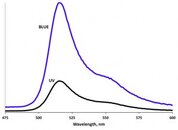You may have heard some dive resorts offer the fluorescent diving, black water diving, where night divers are given UV lights to observe see corals, critters, and enjoy the spectacular show of colors. Advanced technology allows the UV to be brought into the diving industry. So how does it work?
As there are chemical compounds contained in the tissue of the corals, some underwater creatures, it react to the UV light causing them to fluoresce in brilliant reds, purples and greens. The results can be quite amazing.
In the beginning of the UV trend, the only lights available fell in the wavelength of about 455nm, which is still within the spectrum of visible light. This light could cause the corals to fluoresce, but it could also create so much visible blue light, which sometimes diminished the impact of the glowing colors. To combat this, divers learned to use a yellow filter which cut back the excess blue, and still allow the fluorescent colors to shine through.
With technology advancing, it makes a new version of the UV LED possible, which has a wavelength just outside the spectrum of visible light at about 395nm. This LED still causes marine life to put on their fluorescent show, but since it’s nearly invisible to the naked eye, only the glowing colors are revealed. And there is no yellow filter needed! Thus, those powerful multi-color dive lights for underwater photography and video are becoming increasingly popular.
As there are chemical compounds contained in the tissue of the corals, some underwater creatures, it react to the UV light causing them to fluoresce in brilliant reds, purples and greens. The results can be quite amazing.
In the beginning of the UV trend, the only lights available fell in the wavelength of about 455nm, which is still within the spectrum of visible light. This light could cause the corals to fluoresce, but it could also create so much visible blue light, which sometimes diminished the impact of the glowing colors. To combat this, divers learned to use a yellow filter which cut back the excess blue, and still allow the fluorescent colors to shine through.
With technology advancing, it makes a new version of the UV LED possible, which has a wavelength just outside the spectrum of visible light at about 395nm. This LED still causes marine life to put on their fluorescent show, but since it’s nearly invisible to the naked eye, only the glowing colors are revealed. And there is no yellow filter needed! Thus, those powerful multi-color dive lights for underwater photography and video are becoming increasingly popular.




